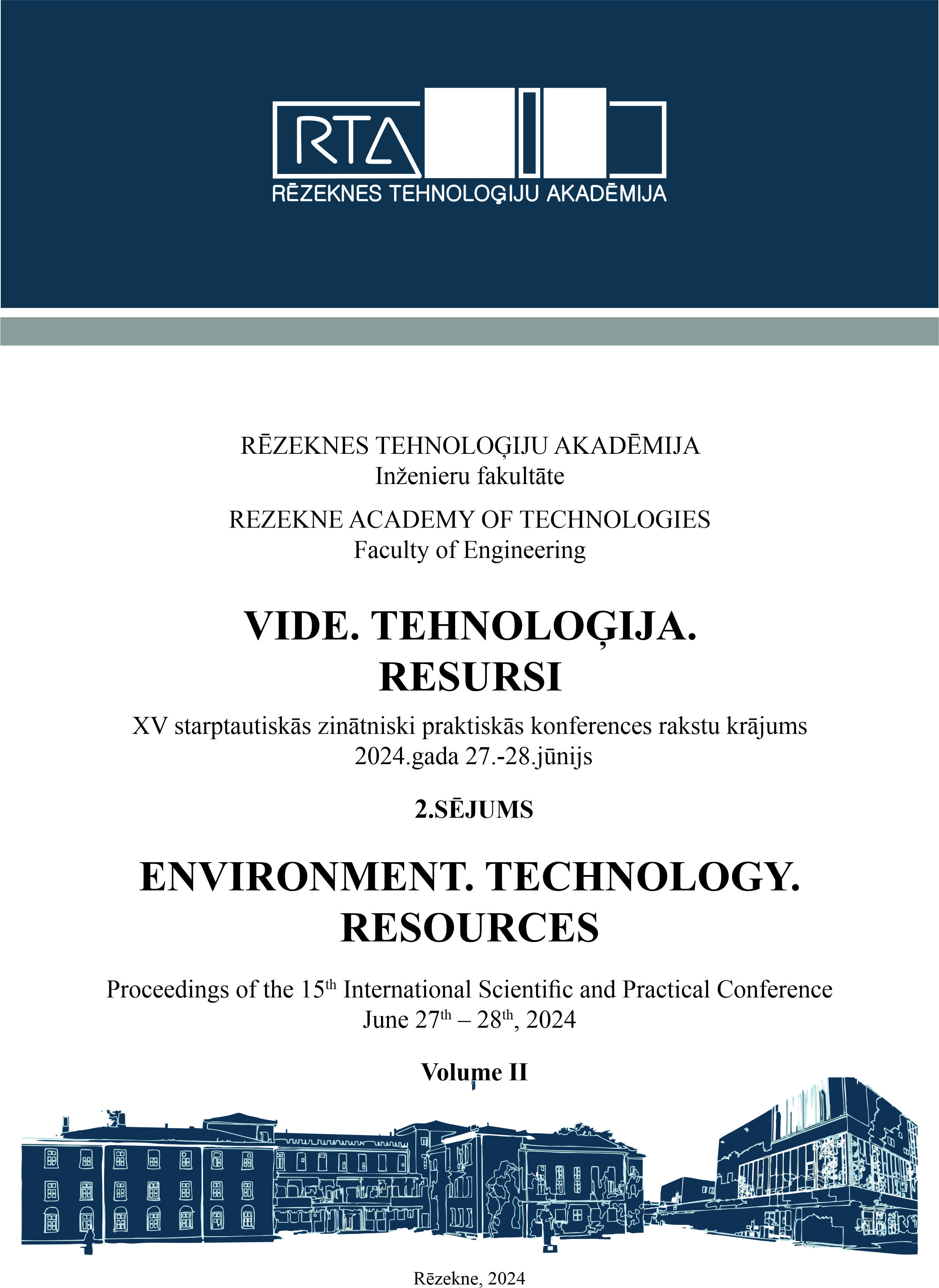EXPLORING THE INTEGRATION OF VIRTUAL REALITY IN PHYSICAL EDUCATION: A COMPREHENSIVE REVIEW
DOI:
https://doi.org/10.17770/etr2024vol2.8057Keywords:
VR, Physical Education, Gamification, Immersion, Personalized Learning, AccessibilityAbstract
Virtual Reality (VR) has emerged as a promising technology with diverse applications across various domains, including education. In the realm of physical education (PE), VR presents an innovative approach to enhance learning experiences, offering immersive environments and interactive simulations. This study provides a comprehensive review of existing literature to explore the integration of VR in PE, focusing on its efficacy, challenges, and potential outcomes.
A systematic search of academic databases, including ProQuest/Web of Science, EBSCO, DOAJ, and Gale databases, was conducted to identify relevant studies published between Jan. 2016 and Feb. 2024. Keywords such as "virtual reality" and “physical education” were used to filter the literature. Studies involving diverse research designs, including experimental trials, case studies, and qualitative analyses, were included in the review.
The review revealed a growing amount of literature exploring the integration of VR in PE, highlighting its potential to enhance engagement, motivation, and skill acquisition among students. Studies reported positive outcomes in various systems around the world. VR-based interventions demonstrated effectiveness in improving performance, knowledge retention, and adherence to exercise regimens. Moreover, immersive simulations enabled experiential learning, providing students with realistic scenarios. However, challenges such as equipment cost, technical limitations, and user discomfort were noted as barriers to widespread adoption. Additionally, concerns were raised regarding the potential isolation of students and the need for adequate supervision in VR environments.
In conclusion, the integration of VR technology in PE shows promise as a valuable tool to enrich teaching and learning experiences. With continued advancements in technology and pedagogy, VR has the potential to revolutionize PE education, providing students with immersive and interactive learning environments conducive to holistic development.
References
A. Raouf Khan and K. Cheng, “Augmented reality for manufacturing,” Springer Series in Advanced Manufacturing, pp. 1–56, 2011. https://doi.org/10.1007/978-0-85729-186-8_1
K. Lee and S. Oh, "The Users’ Intention to Participate in a VR/AR Sports Experience by Applying the Extended Technology Acceptance Model (ETAM)," Healthcare, vol. 10, no. 1117, 2022, https://doi.org/10.3390/healthcare10061117
F. Ji, X. Zhang, Zhao, S., and Fang, Q. (2023). Virtual reality: a promising instrument to promote sail education. Frontiers in Psychology, 14:1185415. https://doi.org/10.3389/fpsyg.2023.1185415
M. Peng, “Evaluation and analysis of the implementation effects in practical-course blended learning based on virtual reality technology,” International Journal of Emerging Technologies in Learning (iJET), vol. 18, no. 15, pp. 94–108, Aug. 2023. https://doi.org/10.3991/ijet.v18i15.42379
N. A. Mokmin and N. N. Ridzuan, “Immersive Technologies in physical education in Malaysia for students with learning disabilities,” IAFOR Journal of Education, vol. 10, no. 2, pp. 91–110, Aug. 2022. https://doi.org/10.22492/ije.10.2.05
K. Zhao and X. Guo, “Analysis of the application of virtual reality technology in football training,” Journal of Sensors, vol. 2022, pp. 1–8, Mar. 2022. https://doi.org/10.1155/2022/1339434
X. Chen, Z. Chen, Y. Li, T. He, J. Hou, S. Liu, Y. He, "ImmerTai: Immersive Motion Learning in VR Environments," in Journal of Visual Communication and Image Representation, vol. 58, pp. 416-427, 2019. https://doi.org/10.1016/j.jvcir.2018.11.039
A. Denche-Zamorano et al., “Rehabilitation is the main topic in virtual and Augmented Reality and Physical Activity Research: A Bibliometric analysis,” Sensors, vol. 23, no. 6, p. 2987, Mar. 2023. https://doi.org/10.3390/s23062987
F. Wang and Z. Wei, "Research on the Application of VR Technology in Physical Education," Frontiers in Sport Research, vol. 2, no. 6, pp. 116-123, 2020, https://doi.org/10.25236/FSR.2020.020615.
N. A. Mokmin and N. N. Ridzuan, “Immersive Technologies in physical education in Malaysia for students with learning disabilities,” IAFOR Journal of Education, vol. 10, no. 2, pp. 91–110, Aug. 2022. https://doi.org/10.22492/ije.10.2.05
L. Whalen, J. Barcelona, E. Centeio, and N. McCaughtry, “#healthykidsquarantined: Supporting schools and families with virtual physical activity, physical education, and nutrition education during the Coronavirus Pandemic,” Journal of Teaching in Physical Education, vol. 40, no. 3, pp. 503–507, Jul. 2021. https://doi.org/10.1123/jtpe.2020-0299
Jiongjiong Fan, "Practical Paths and Countermeasures to Improve the Quality of Physical Education for Future Metaverse Education: Evidence from A Study in China," International Journal of Education (IJE), vol. 4, no. 01, pp. 60-86, 2023, https://doi.org/10.17605/OSF.IO/47KPZ
X. HE, “A conceptual exploration: Incorporating physical education with metaverse,” International Journal of Education and Literacy Studies, vol. 11, no. 4, pp. 325–331, Oct. 2023. https://doi.org/10.7575/aiac.ijels.v.11n.4p.325
K.-E. Chang, J. Zhang, Y.-S. Huang, T.-C. Liu, and Y.-T. Sung, “Applying augmented reality in physical education on Motor Skills Learning,” Interactive Learning Environments, vol. 28, no. 6, pp. 685–697, Jun. 2019. https://doi.org/10.1080/10494820.2019.1636073
N. Wang, M. N. Abdul Rahman, and B.-H. Lim, “Teaching and curriculum of the preschool physical education major direction in colleges and universities under Virtual Reality Technology,” Computational Intelligence and Neuroscience, vol. 2022, pp. 1–10, Mar. 2022. https://doi.org/10.1155/2022/3250986
W. Chen, “College cross-country skiing teaching and sports training based on VR,” Mathematical Problems in Engineering, vol. 2022, pp. 1–9, Mar. 2022. https://doi.org/10.1155/2022/8301746
Y. Dong, “Analysis of intelligent physical education teaching scheme based on 5G communication + VR technology,” Mobile Information Systems, vol. 2022, pp. 1–8, Apr. 2022. https://doi.org/10.1155/2022/8598077
M. Geisen, A. Fox, and S. Klatt, “VR as an innovative learning tool in sports education,” Applied Sciences, vol. 13, no. 4, p. 2239, Feb. 2023. https://doi.org/10.3390/app13042239
Xiuzu Xiong, "A New Physical Education Teaching System and Training Framework Based on Human-Computer Interaction and Auxiliary Interaction," IJET, Vol. 16, No. 14, 2021, https://doi.org/10.3991/ijet.v16i14.24045. Yuehong Shi, "The Application of Computer VR Technology in Physical Education," Applied Mathematics and Nonlinear vol. 9, no. 1, 2024, https://doi.org/10.2478/amns.2023.2.00252
Downloads
Published
Issue
Section
License
Copyright (c) 2024 Milena Kuleva

This work is licensed under a Creative Commons Attribution 4.0 International License.



